NURS2003 | Pathophysiology of the Disease of the Patient
VerifiedAdded on 2022/09/07
|10
|2742
|22
AI Summary
Contribute Materials
Your contribution can guide someone’s learning journey. Share your
documents today.
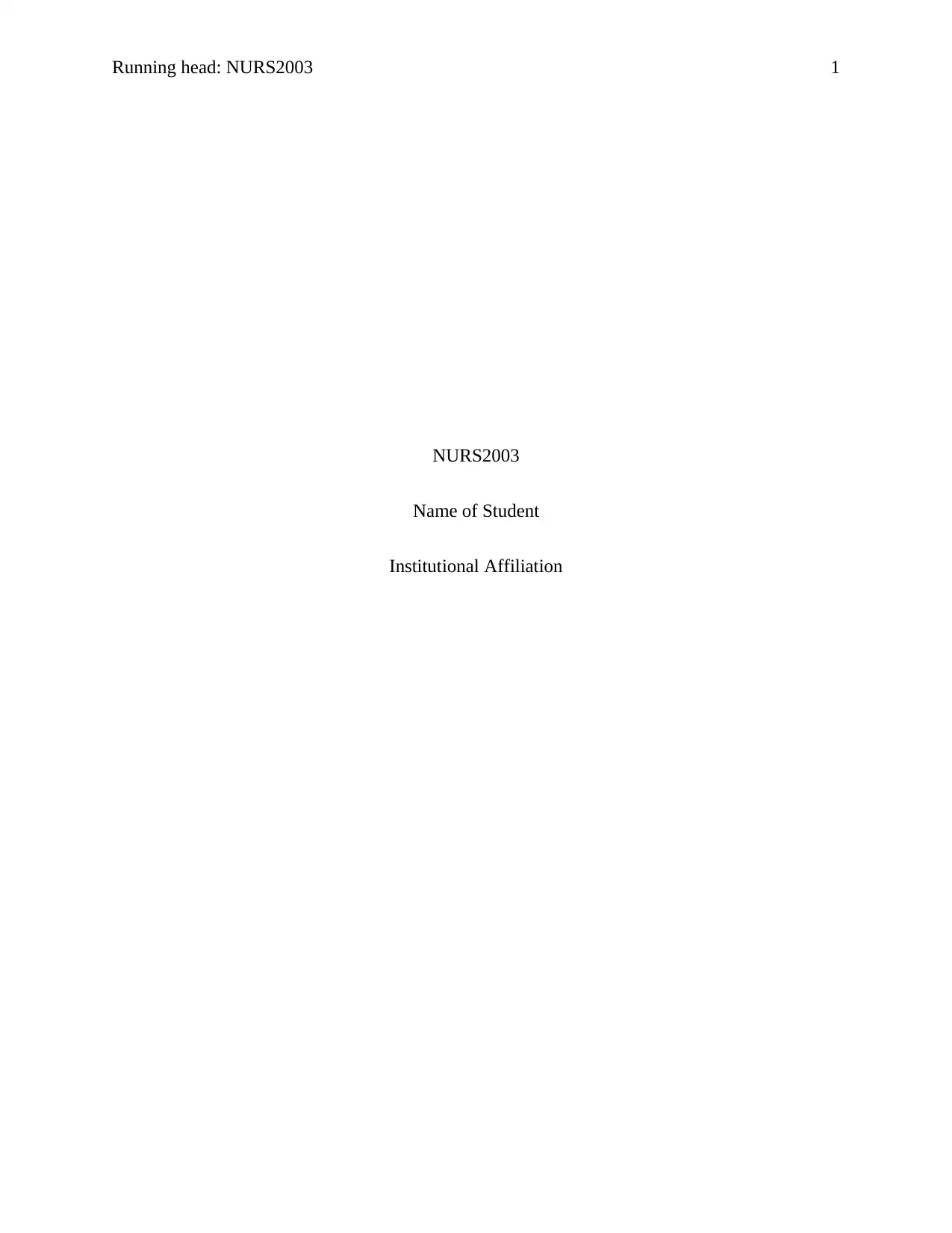
Running head: NURS2003 1
NURS2003
Name of Student
Institutional Affiliation
NURS2003
Name of Student
Institutional Affiliation
Secure Best Marks with AI Grader
Need help grading? Try our AI Grader for instant feedback on your assignments.
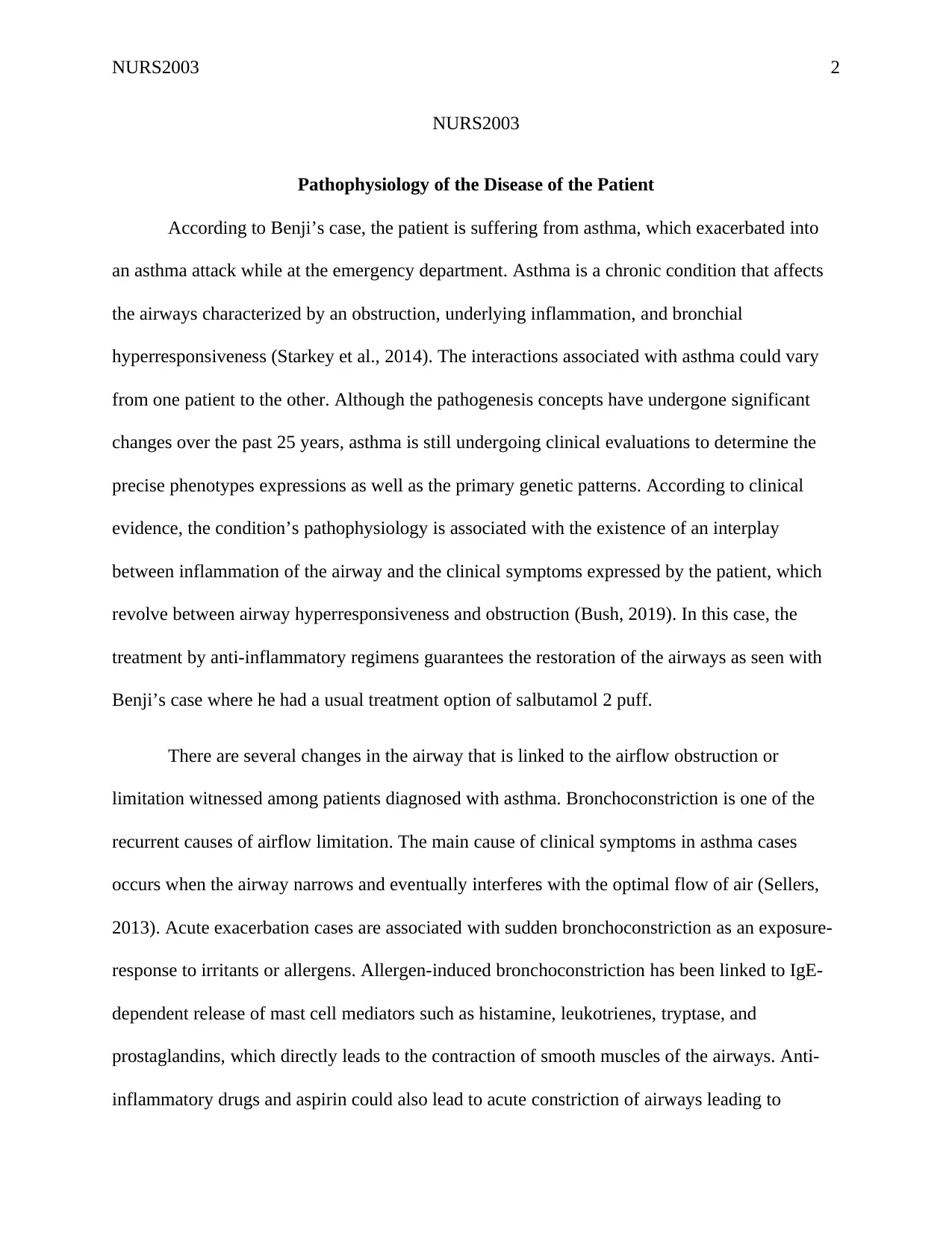
NURS2003 2
NURS2003
Pathophysiology of the Disease of the Patient
According to Benji’s case, the patient is suffering from asthma, which exacerbated into
an asthma attack while at the emergency department. Asthma is a chronic condition that affects
the airways characterized by an obstruction, underlying inflammation, and bronchial
hyperresponsiveness (Starkey et al., 2014). The interactions associated with asthma could vary
from one patient to the other. Although the pathogenesis concepts have undergone significant
changes over the past 25 years, asthma is still undergoing clinical evaluations to determine the
precise phenotypes expressions as well as the primary genetic patterns. According to clinical
evidence, the condition’s pathophysiology is associated with the existence of an interplay
between inflammation of the airway and the clinical symptoms expressed by the patient, which
revolve between airway hyperresponsiveness and obstruction (Bush, 2019). In this case, the
treatment by anti-inflammatory regimens guarantees the restoration of the airways as seen with
Benji’s case where he had a usual treatment option of salbutamol 2 puff.
There are several changes in the airway that is linked to the airflow obstruction or
limitation witnessed among patients diagnosed with asthma. Bronchoconstriction is one of the
recurrent causes of airflow limitation. The main cause of clinical symptoms in asthma cases
occurs when the airway narrows and eventually interferes with the optimal flow of air (Sellers,
2013). Acute exacerbation cases are associated with sudden bronchoconstriction as an exposure-
response to irritants or allergens. Allergen-induced bronchoconstriction has been linked to IgE-
dependent release of mast cell mediators such as histamine, leukotrienes, tryptase, and
prostaglandins, which directly leads to the contraction of smooth muscles of the airways. Anti-
inflammatory drugs and aspirin could also lead to acute constriction of airways leading to
NURS2003
Pathophysiology of the Disease of the Patient
According to Benji’s case, the patient is suffering from asthma, which exacerbated into
an asthma attack while at the emergency department. Asthma is a chronic condition that affects
the airways characterized by an obstruction, underlying inflammation, and bronchial
hyperresponsiveness (Starkey et al., 2014). The interactions associated with asthma could vary
from one patient to the other. Although the pathogenesis concepts have undergone significant
changes over the past 25 years, asthma is still undergoing clinical evaluations to determine the
precise phenotypes expressions as well as the primary genetic patterns. According to clinical
evidence, the condition’s pathophysiology is associated with the existence of an interplay
between inflammation of the airway and the clinical symptoms expressed by the patient, which
revolve between airway hyperresponsiveness and obstruction (Bush, 2019). In this case, the
treatment by anti-inflammatory regimens guarantees the restoration of the airways as seen with
Benji’s case where he had a usual treatment option of salbutamol 2 puff.
There are several changes in the airway that is linked to the airflow obstruction or
limitation witnessed among patients diagnosed with asthma. Bronchoconstriction is one of the
recurrent causes of airflow limitation. The main cause of clinical symptoms in asthma cases
occurs when the airway narrows and eventually interferes with the optimal flow of air (Sellers,
2013). Acute exacerbation cases are associated with sudden bronchoconstriction as an exposure-
response to irritants or allergens. Allergen-induced bronchoconstriction has been linked to IgE-
dependent release of mast cell mediators such as histamine, leukotrienes, tryptase, and
prostaglandins, which directly leads to the contraction of smooth muscles of the airways. Anti-
inflammatory drugs and aspirin could also lead to acute constriction of airways leading to
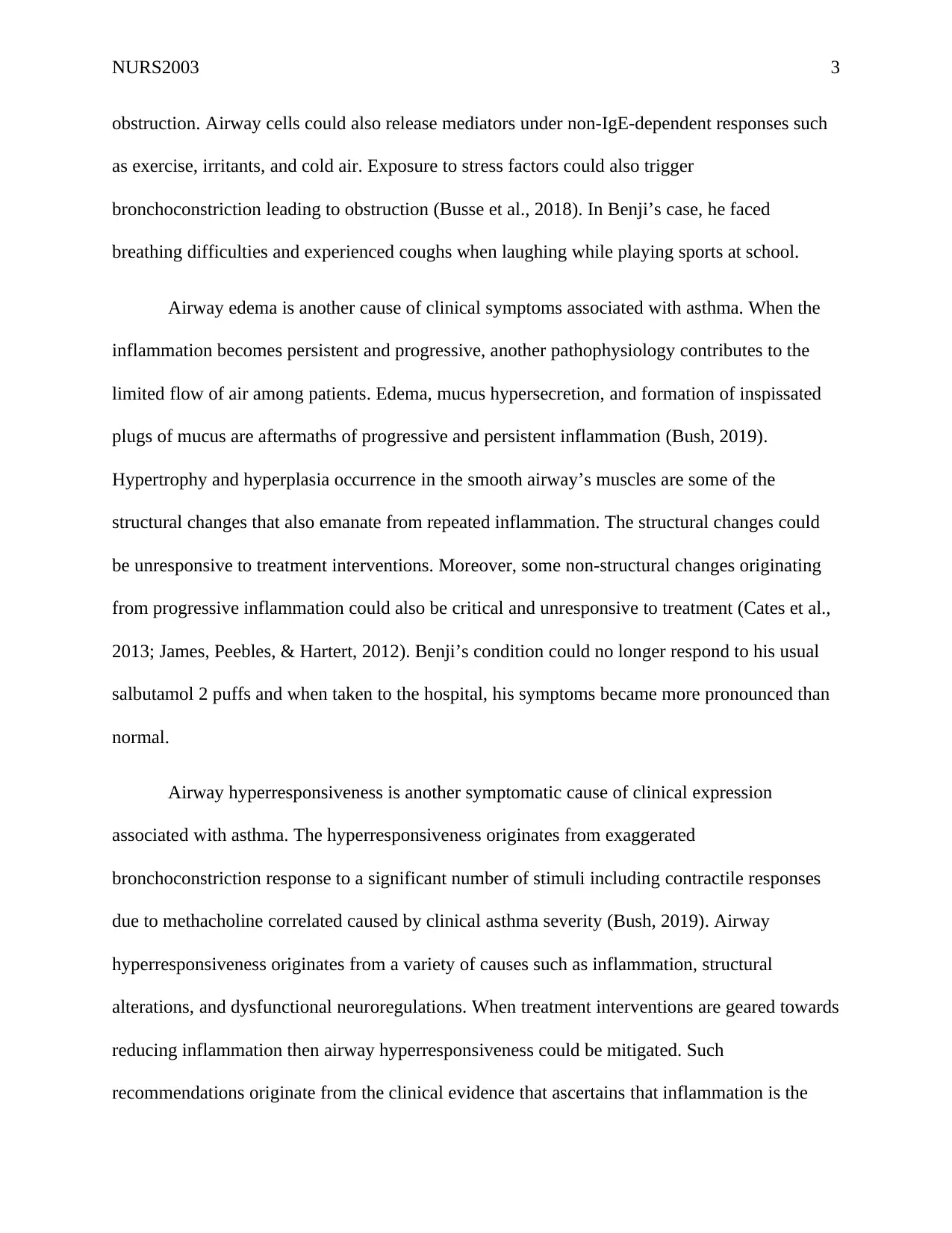
NURS2003 3
obstruction. Airway cells could also release mediators under non-IgE-dependent responses such
as exercise, irritants, and cold air. Exposure to stress factors could also trigger
bronchoconstriction leading to obstruction (Busse et al., 2018). In Benji’s case, he faced
breathing difficulties and experienced coughs when laughing while playing sports at school.
Airway edema is another cause of clinical symptoms associated with asthma. When the
inflammation becomes persistent and progressive, another pathophysiology contributes to the
limited flow of air among patients. Edema, mucus hypersecretion, and formation of inspissated
plugs of mucus are aftermaths of progressive and persistent inflammation (Bush, 2019).
Hypertrophy and hyperplasia occurrence in the smooth airway’s muscles are some of the
structural changes that also emanate from repeated inflammation. The structural changes could
be unresponsive to treatment interventions. Moreover, some non-structural changes originating
from progressive inflammation could also be critical and unresponsive to treatment (Cates et al.,
2013; James, Peebles, & Hartert, 2012). Benji’s condition could no longer respond to his usual
salbutamol 2 puffs and when taken to the hospital, his symptoms became more pronounced than
normal.
Airway hyperresponsiveness is another symptomatic cause of clinical expression
associated with asthma. The hyperresponsiveness originates from exaggerated
bronchoconstriction response to a significant number of stimuli including contractile responses
due to methacholine correlated caused by clinical asthma severity (Bush, 2019). Airway
hyperresponsiveness originates from a variety of causes such as inflammation, structural
alterations, and dysfunctional neuroregulations. When treatment interventions are geared towards
reducing inflammation then airway hyperresponsiveness could be mitigated. Such
recommendations originate from the clinical evidence that ascertains that inflammation is the
obstruction. Airway cells could also release mediators under non-IgE-dependent responses such
as exercise, irritants, and cold air. Exposure to stress factors could also trigger
bronchoconstriction leading to obstruction (Busse et al., 2018). In Benji’s case, he faced
breathing difficulties and experienced coughs when laughing while playing sports at school.
Airway edema is another cause of clinical symptoms associated with asthma. When the
inflammation becomes persistent and progressive, another pathophysiology contributes to the
limited flow of air among patients. Edema, mucus hypersecretion, and formation of inspissated
plugs of mucus are aftermaths of progressive and persistent inflammation (Bush, 2019).
Hypertrophy and hyperplasia occurrence in the smooth airway’s muscles are some of the
structural changes that also emanate from repeated inflammation. The structural changes could
be unresponsive to treatment interventions. Moreover, some non-structural changes originating
from progressive inflammation could also be critical and unresponsive to treatment (Cates et al.,
2013; James, Peebles, & Hartert, 2012). Benji’s condition could no longer respond to his usual
salbutamol 2 puffs and when taken to the hospital, his symptoms became more pronounced than
normal.
Airway hyperresponsiveness is another symptomatic cause of clinical expression
associated with asthma. The hyperresponsiveness originates from exaggerated
bronchoconstriction response to a significant number of stimuli including contractile responses
due to methacholine correlated caused by clinical asthma severity (Bush, 2019). Airway
hyperresponsiveness originates from a variety of causes such as inflammation, structural
alterations, and dysfunctional neuroregulations. When treatment interventions are geared towards
reducing inflammation then airway hyperresponsiveness could be mitigated. Such
recommendations originate from the clinical evidence that ascertains that inflammation is the
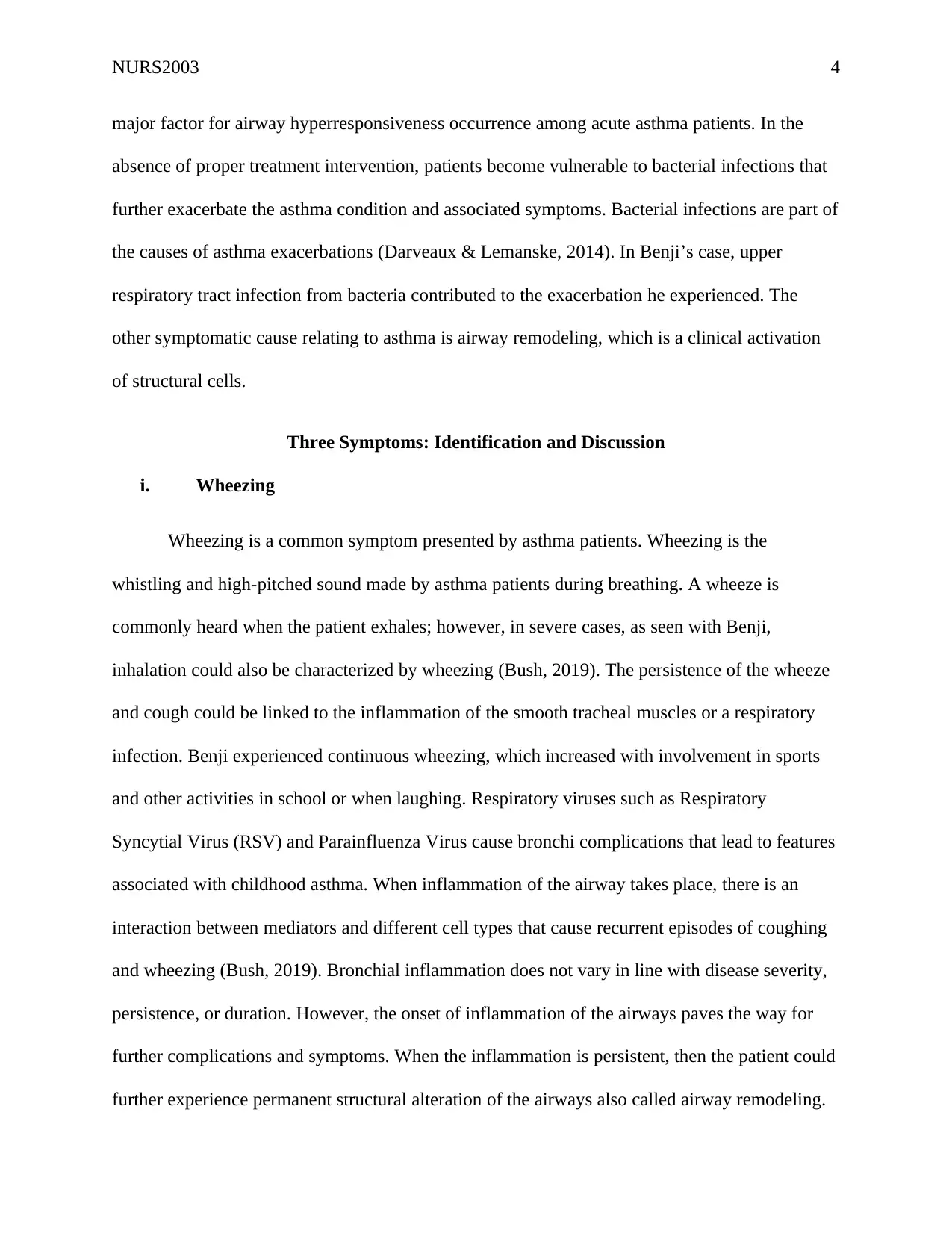
NURS2003 4
major factor for airway hyperresponsiveness occurrence among acute asthma patients. In the
absence of proper treatment intervention, patients become vulnerable to bacterial infections that
further exacerbate the asthma condition and associated symptoms. Bacterial infections are part of
the causes of asthma exacerbations (Darveaux & Lemanske, 2014). In Benji’s case, upper
respiratory tract infection from bacteria contributed to the exacerbation he experienced. The
other symptomatic cause relating to asthma is airway remodeling, which is a clinical activation
of structural cells.
Three Symptoms: Identification and Discussion
i. Wheezing
Wheezing is a common symptom presented by asthma patients. Wheezing is the
whistling and high-pitched sound made by asthma patients during breathing. A wheeze is
commonly heard when the patient exhales; however, in severe cases, as seen with Benji,
inhalation could also be characterized by wheezing (Bush, 2019). The persistence of the wheeze
and cough could be linked to the inflammation of the smooth tracheal muscles or a respiratory
infection. Benji experienced continuous wheezing, which increased with involvement in sports
and other activities in school or when laughing. Respiratory viruses such as Respiratory
Syncytial Virus (RSV) and Parainfluenza Virus cause bronchi complications that lead to features
associated with childhood asthma. When inflammation of the airway takes place, there is an
interaction between mediators and different cell types that cause recurrent episodes of coughing
and wheezing (Bush, 2019). Bronchial inflammation does not vary in line with disease severity,
persistence, or duration. However, the onset of inflammation of the airways paves the way for
further complications and symptoms. When the inflammation is persistent, then the patient could
further experience permanent structural alteration of the airways also called airway remodeling.
major factor for airway hyperresponsiveness occurrence among acute asthma patients. In the
absence of proper treatment intervention, patients become vulnerable to bacterial infections that
further exacerbate the asthma condition and associated symptoms. Bacterial infections are part of
the causes of asthma exacerbations (Darveaux & Lemanske, 2014). In Benji’s case, upper
respiratory tract infection from bacteria contributed to the exacerbation he experienced. The
other symptomatic cause relating to asthma is airway remodeling, which is a clinical activation
of structural cells.
Three Symptoms: Identification and Discussion
i. Wheezing
Wheezing is a common symptom presented by asthma patients. Wheezing is the
whistling and high-pitched sound made by asthma patients during breathing. A wheeze is
commonly heard when the patient exhales; however, in severe cases, as seen with Benji,
inhalation could also be characterized by wheezing (Bush, 2019). The persistence of the wheeze
and cough could be linked to the inflammation of the smooth tracheal muscles or a respiratory
infection. Benji experienced continuous wheezing, which increased with involvement in sports
and other activities in school or when laughing. Respiratory viruses such as Respiratory
Syncytial Virus (RSV) and Parainfluenza Virus cause bronchi complications that lead to features
associated with childhood asthma. When inflammation of the airway takes place, there is an
interaction between mediators and different cell types that cause recurrent episodes of coughing
and wheezing (Bush, 2019). Bronchial inflammation does not vary in line with disease severity,
persistence, or duration. However, the onset of inflammation of the airways paves the way for
further complications and symptoms. When the inflammation is persistent, then the patient could
further experience permanent structural alteration of the airways also called airway remodeling.
Secure Best Marks with AI Grader
Need help grading? Try our AI Grader for instant feedback on your assignments.
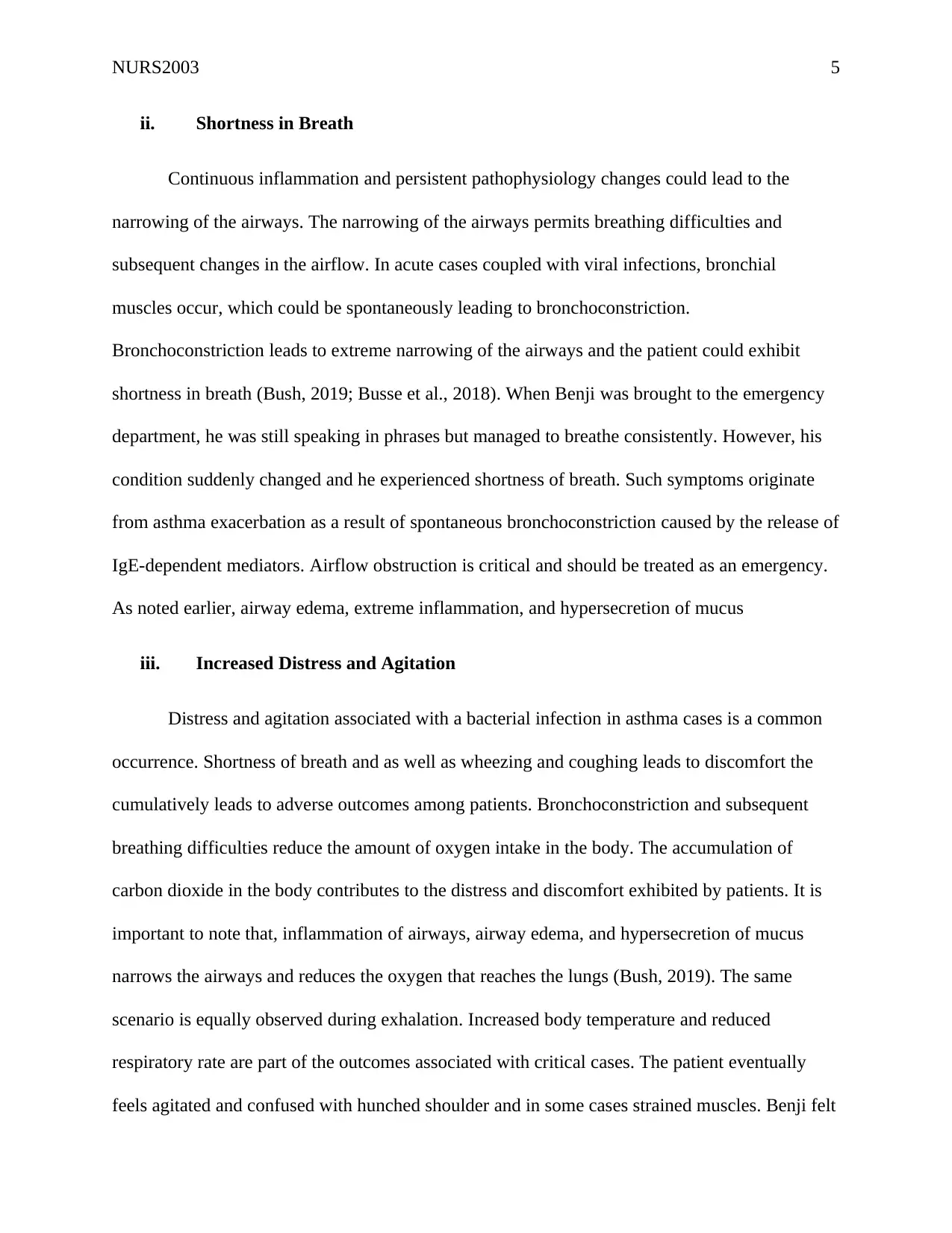
NURS2003 5
ii. Shortness in Breath
Continuous inflammation and persistent pathophysiology changes could lead to the
narrowing of the airways. The narrowing of the airways permits breathing difficulties and
subsequent changes in the airflow. In acute cases coupled with viral infections, bronchial
muscles occur, which could be spontaneously leading to bronchoconstriction.
Bronchoconstriction leads to extreme narrowing of the airways and the patient could exhibit
shortness in breath (Bush, 2019; Busse et al., 2018). When Benji was brought to the emergency
department, he was still speaking in phrases but managed to breathe consistently. However, his
condition suddenly changed and he experienced shortness of breath. Such symptoms originate
from asthma exacerbation as a result of spontaneous bronchoconstriction caused by the release of
IgE-dependent mediators. Airflow obstruction is critical and should be treated as an emergency.
As noted earlier, airway edema, extreme inflammation, and hypersecretion of mucus
iii. Increased Distress and Agitation
Distress and agitation associated with a bacterial infection in asthma cases is a common
occurrence. Shortness of breath and as well as wheezing and coughing leads to discomfort the
cumulatively leads to adverse outcomes among patients. Bronchoconstriction and subsequent
breathing difficulties reduce the amount of oxygen intake in the body. The accumulation of
carbon dioxide in the body contributes to the distress and discomfort exhibited by patients. It is
important to note that, inflammation of airways, airway edema, and hypersecretion of mucus
narrows the airways and reduces the oxygen that reaches the lungs (Bush, 2019). The same
scenario is equally observed during exhalation. Increased body temperature and reduced
respiratory rate are part of the outcomes associated with critical cases. The patient eventually
feels agitated and confused with hunched shoulder and in some cases strained muscles. Benji felt
ii. Shortness in Breath
Continuous inflammation and persistent pathophysiology changes could lead to the
narrowing of the airways. The narrowing of the airways permits breathing difficulties and
subsequent changes in the airflow. In acute cases coupled with viral infections, bronchial
muscles occur, which could be spontaneously leading to bronchoconstriction.
Bronchoconstriction leads to extreme narrowing of the airways and the patient could exhibit
shortness in breath (Bush, 2019; Busse et al., 2018). When Benji was brought to the emergency
department, he was still speaking in phrases but managed to breathe consistently. However, his
condition suddenly changed and he experienced shortness of breath. Such symptoms originate
from asthma exacerbation as a result of spontaneous bronchoconstriction caused by the release of
IgE-dependent mediators. Airflow obstruction is critical and should be treated as an emergency.
As noted earlier, airway edema, extreme inflammation, and hypersecretion of mucus
iii. Increased Distress and Agitation
Distress and agitation associated with a bacterial infection in asthma cases is a common
occurrence. Shortness of breath and as well as wheezing and coughing leads to discomfort the
cumulatively leads to adverse outcomes among patients. Bronchoconstriction and subsequent
breathing difficulties reduce the amount of oxygen intake in the body. The accumulation of
carbon dioxide in the body contributes to the distress and discomfort exhibited by patients. It is
important to note that, inflammation of airways, airway edema, and hypersecretion of mucus
narrows the airways and reduces the oxygen that reaches the lungs (Bush, 2019). The same
scenario is equally observed during exhalation. Increased body temperature and reduced
respiratory rate are part of the outcomes associated with critical cases. The patient eventually
feels agitated and confused with hunched shoulder and in some cases strained muscles. Benji felt
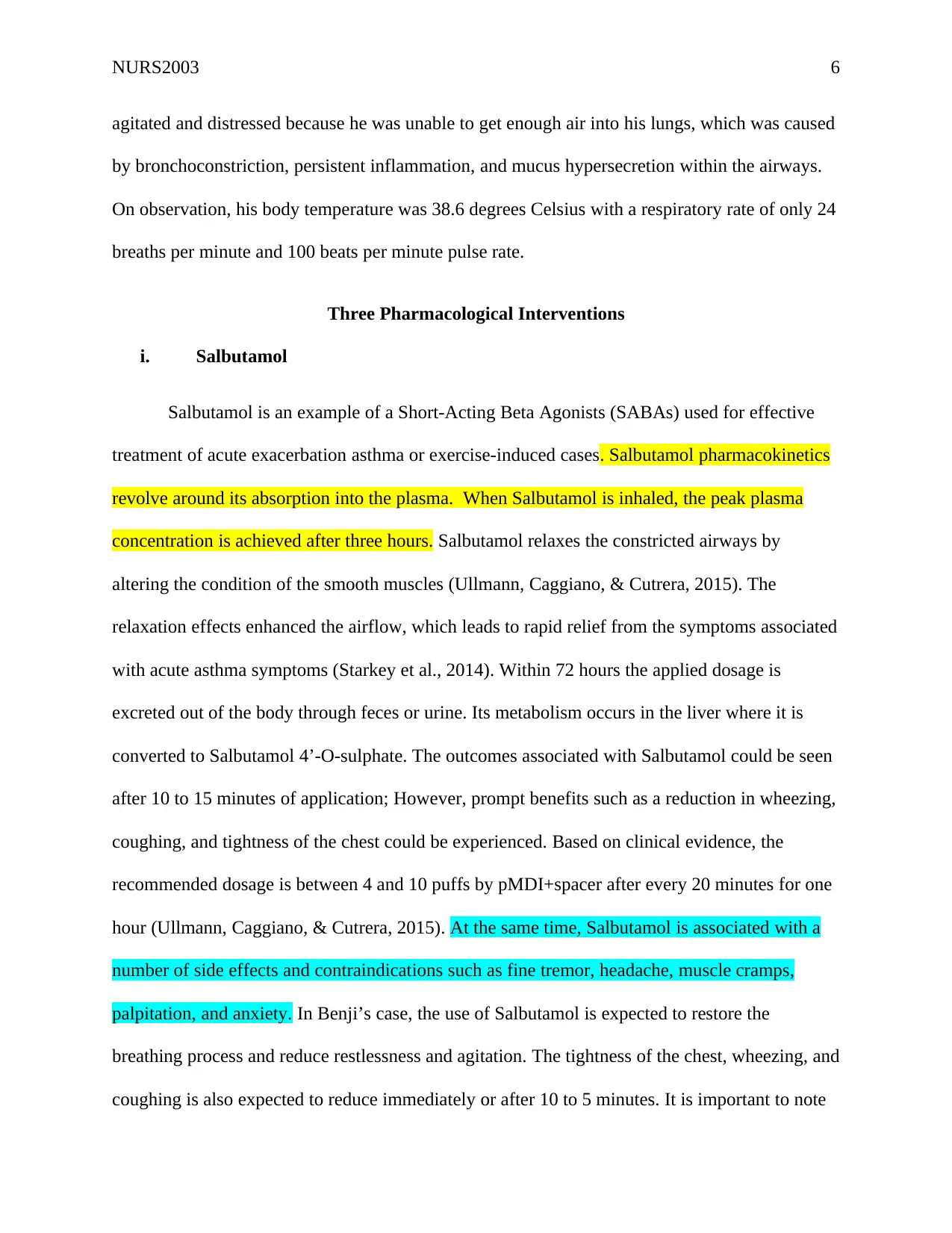
NURS2003 6
agitated and distressed because he was unable to get enough air into his lungs, which was caused
by bronchoconstriction, persistent inflammation, and mucus hypersecretion within the airways.
On observation, his body temperature was 38.6 degrees Celsius with a respiratory rate of only 24
breaths per minute and 100 beats per minute pulse rate.
Three Pharmacological Interventions
i. Salbutamol
Salbutamol is an example of a Short-Acting Beta Agonists (SABAs) used for effective
treatment of acute exacerbation asthma or exercise-induced cases. Salbutamol pharmacokinetics
revolve around its absorption into the plasma. When Salbutamol is inhaled, the peak plasma
concentration is achieved after three hours. Salbutamol relaxes the constricted airways by
altering the condition of the smooth muscles (Ullmann, Caggiano, & Cutrera, 2015). The
relaxation effects enhanced the airflow, which leads to rapid relief from the symptoms associated
with acute asthma symptoms (Starkey et al., 2014). Within 72 hours the applied dosage is
excreted out of the body through feces or urine. Its metabolism occurs in the liver where it is
converted to Salbutamol 4’-O-sulphate. The outcomes associated with Salbutamol could be seen
after 10 to 15 minutes of application; However, prompt benefits such as a reduction in wheezing,
coughing, and tightness of the chest could be experienced. Based on clinical evidence, the
recommended dosage is between 4 and 10 puffs by pMDI+spacer after every 20 minutes for one
hour (Ullmann, Caggiano, & Cutrera, 2015). At the same time, Salbutamol is associated with a
number of side effects and contraindications such as fine tremor, headache, muscle cramps,
palpitation, and anxiety. In Benji’s case, the use of Salbutamol is expected to restore the
breathing process and reduce restlessness and agitation. The tightness of the chest, wheezing, and
coughing is also expected to reduce immediately or after 10 to 5 minutes. It is important to note
agitated and distressed because he was unable to get enough air into his lungs, which was caused
by bronchoconstriction, persistent inflammation, and mucus hypersecretion within the airways.
On observation, his body temperature was 38.6 degrees Celsius with a respiratory rate of only 24
breaths per minute and 100 beats per minute pulse rate.
Three Pharmacological Interventions
i. Salbutamol
Salbutamol is an example of a Short-Acting Beta Agonists (SABAs) used for effective
treatment of acute exacerbation asthma or exercise-induced cases. Salbutamol pharmacokinetics
revolve around its absorption into the plasma. When Salbutamol is inhaled, the peak plasma
concentration is achieved after three hours. Salbutamol relaxes the constricted airways by
altering the condition of the smooth muscles (Ullmann, Caggiano, & Cutrera, 2015). The
relaxation effects enhanced the airflow, which leads to rapid relief from the symptoms associated
with acute asthma symptoms (Starkey et al., 2014). Within 72 hours the applied dosage is
excreted out of the body through feces or urine. Its metabolism occurs in the liver where it is
converted to Salbutamol 4’-O-sulphate. The outcomes associated with Salbutamol could be seen
after 10 to 15 minutes of application; However, prompt benefits such as a reduction in wheezing,
coughing, and tightness of the chest could be experienced. Based on clinical evidence, the
recommended dosage is between 4 and 10 puffs by pMDI+spacer after every 20 minutes for one
hour (Ullmann, Caggiano, & Cutrera, 2015). At the same time, Salbutamol is associated with a
number of side effects and contraindications such as fine tremor, headache, muscle cramps,
palpitation, and anxiety. In Benji’s case, the use of Salbutamol is expected to restore the
breathing process and reduce restlessness and agitation. The tightness of the chest, wheezing, and
coughing is also expected to reduce immediately or after 10 to 5 minutes. It is important to note
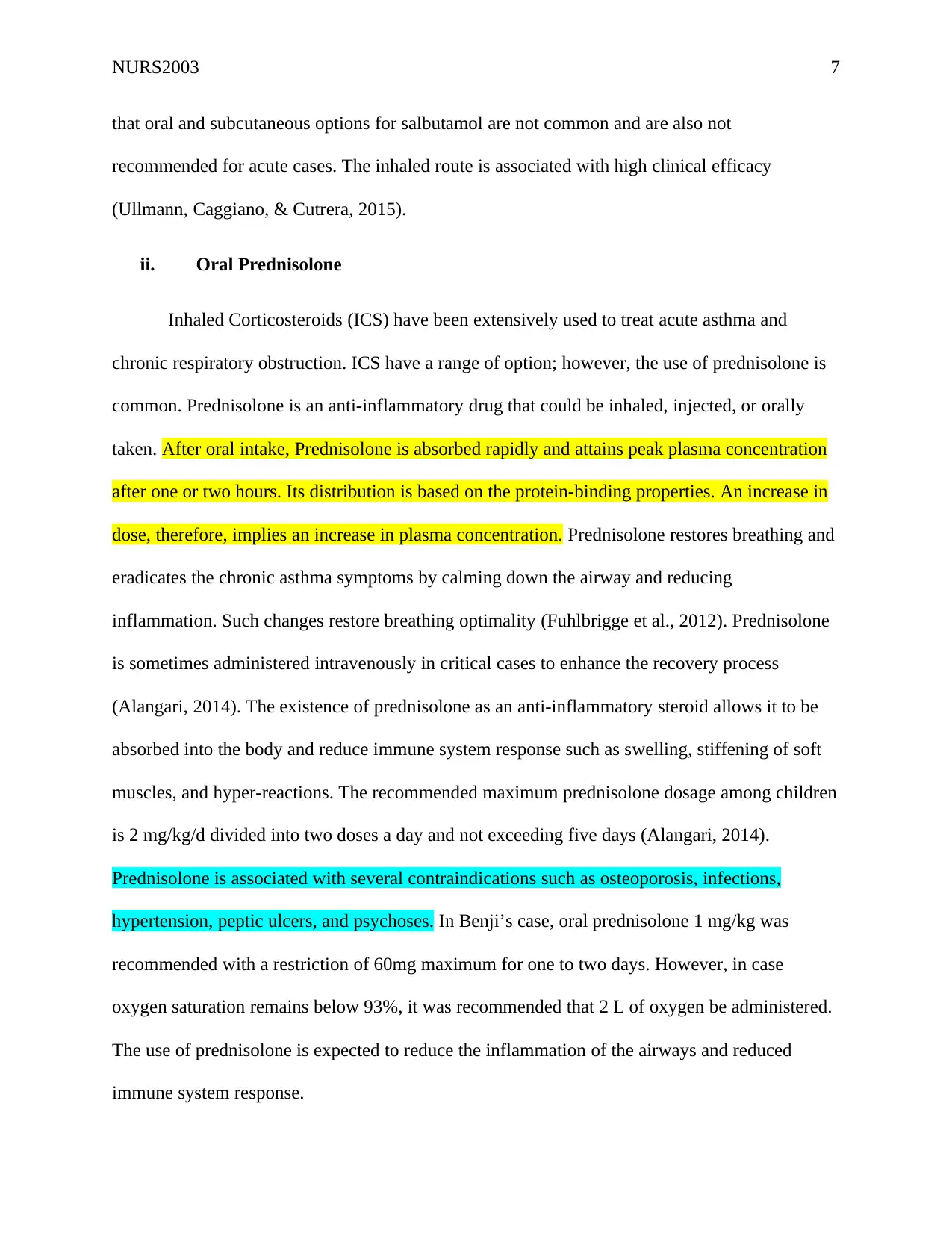
NURS2003 7
that oral and subcutaneous options for salbutamol are not common and are also not
recommended for acute cases. The inhaled route is associated with high clinical efficacy
(Ullmann, Caggiano, & Cutrera, 2015).
ii. Oral Prednisolone
Inhaled Corticosteroids (ICS) have been extensively used to treat acute asthma and
chronic respiratory obstruction. ICS have a range of option; however, the use of prednisolone is
common. Prednisolone is an anti-inflammatory drug that could be inhaled, injected, or orally
taken. After oral intake, Prednisolone is absorbed rapidly and attains peak plasma concentration
after one or two hours. Its distribution is based on the protein-binding properties. An increase in
dose, therefore, implies an increase in plasma concentration. Prednisolone restores breathing and
eradicates the chronic asthma symptoms by calming down the airway and reducing
inflammation. Such changes restore breathing optimality (Fuhlbrigge et al., 2012). Prednisolone
is sometimes administered intravenously in critical cases to enhance the recovery process
(Alangari, 2014). The existence of prednisolone as an anti-inflammatory steroid allows it to be
absorbed into the body and reduce immune system response such as swelling, stiffening of soft
muscles, and hyper-reactions. The recommended maximum prednisolone dosage among children
is 2 mg/kg/d divided into two doses a day and not exceeding five days (Alangari, 2014).
Prednisolone is associated with several contraindications such as osteoporosis, infections,
hypertension, peptic ulcers, and psychoses. In Benji’s case, oral prednisolone 1 mg/kg was
recommended with a restriction of 60mg maximum for one to two days. However, in case
oxygen saturation remains below 93%, it was recommended that 2 L of oxygen be administered.
The use of prednisolone is expected to reduce the inflammation of the airways and reduced
immune system response.
that oral and subcutaneous options for salbutamol are not common and are also not
recommended for acute cases. The inhaled route is associated with high clinical efficacy
(Ullmann, Caggiano, & Cutrera, 2015).
ii. Oral Prednisolone
Inhaled Corticosteroids (ICS) have been extensively used to treat acute asthma and
chronic respiratory obstruction. ICS have a range of option; however, the use of prednisolone is
common. Prednisolone is an anti-inflammatory drug that could be inhaled, injected, or orally
taken. After oral intake, Prednisolone is absorbed rapidly and attains peak plasma concentration
after one or two hours. Its distribution is based on the protein-binding properties. An increase in
dose, therefore, implies an increase in plasma concentration. Prednisolone restores breathing and
eradicates the chronic asthma symptoms by calming down the airway and reducing
inflammation. Such changes restore breathing optimality (Fuhlbrigge et al., 2012). Prednisolone
is sometimes administered intravenously in critical cases to enhance the recovery process
(Alangari, 2014). The existence of prednisolone as an anti-inflammatory steroid allows it to be
absorbed into the body and reduce immune system response such as swelling, stiffening of soft
muscles, and hyper-reactions. The recommended maximum prednisolone dosage among children
is 2 mg/kg/d divided into two doses a day and not exceeding five days (Alangari, 2014).
Prednisolone is associated with several contraindications such as osteoporosis, infections,
hypertension, peptic ulcers, and psychoses. In Benji’s case, oral prednisolone 1 mg/kg was
recommended with a restriction of 60mg maximum for one to two days. However, in case
oxygen saturation remains below 93%, it was recommended that 2 L of oxygen be administered.
The use of prednisolone is expected to reduce the inflammation of the airways and reduced
immune system response.
Paraphrase This Document
Need a fresh take? Get an instant paraphrase of this document with our AI Paraphraser
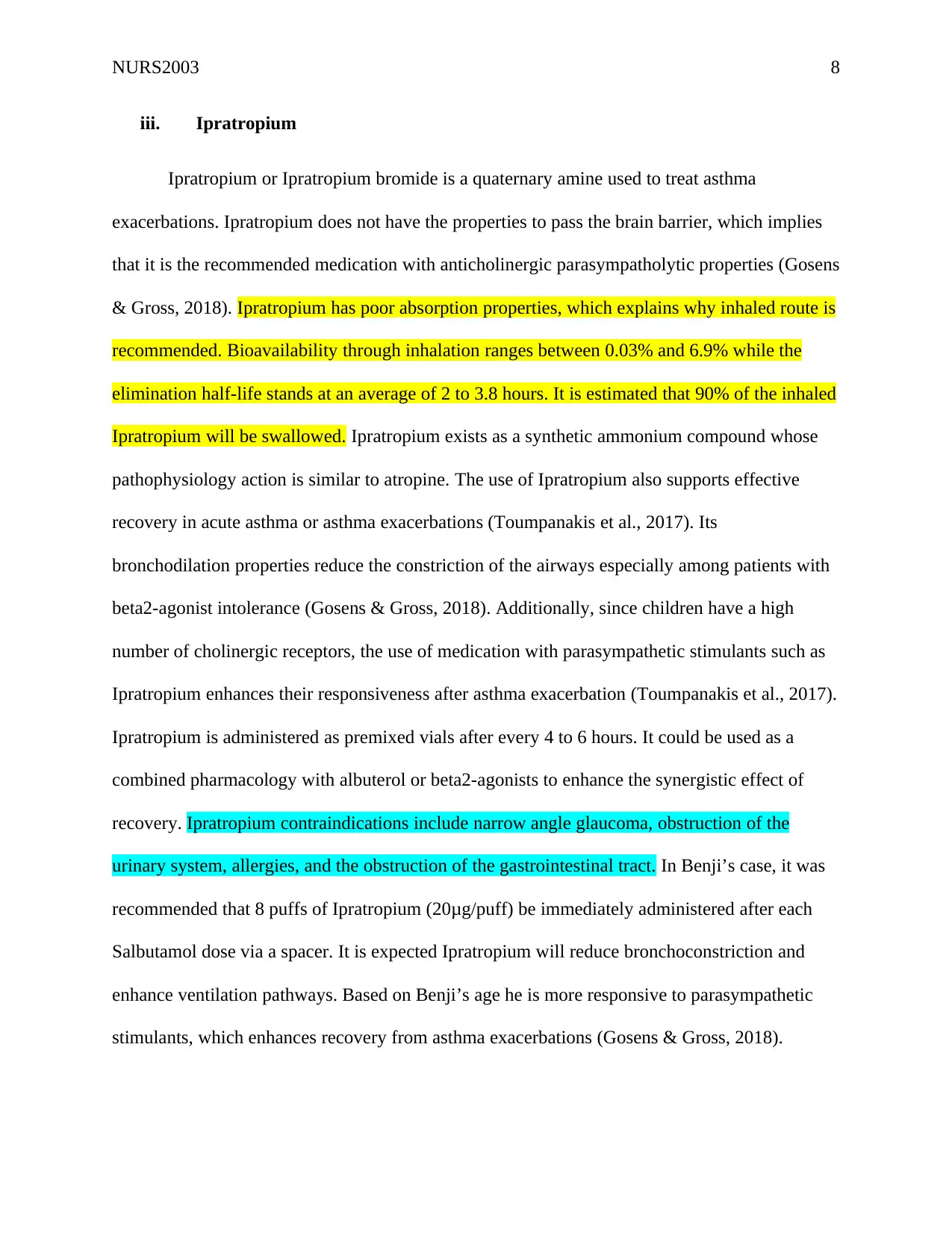
NURS2003 8
iii. Ipratropium
Ipratropium or Ipratropium bromide is a quaternary amine used to treat asthma
exacerbations. Ipratropium does not have the properties to pass the brain barrier, which implies
that it is the recommended medication with anticholinergic parasympatholytic properties (Gosens
& Gross, 2018). Ipratropium has poor absorption properties, which explains why inhaled route is
recommended. Bioavailability through inhalation ranges between 0.03% and 6.9% while the
elimination half-life stands at an average of 2 to 3.8 hours. It is estimated that 90% of the inhaled
Ipratropium will be swallowed. Ipratropium exists as a synthetic ammonium compound whose
pathophysiology action is similar to atropine. The use of Ipratropium also supports effective
recovery in acute asthma or asthma exacerbations (Toumpanakis et al., 2017). Its
bronchodilation properties reduce the constriction of the airways especially among patients with
beta2-agonist intolerance (Gosens & Gross, 2018). Additionally, since children have a high
number of cholinergic receptors, the use of medication with parasympathetic stimulants such as
Ipratropium enhances their responsiveness after asthma exacerbation (Toumpanakis et al., 2017).
Ipratropium is administered as premixed vials after every 4 to 6 hours. It could be used as a
combined pharmacology with albuterol or beta2-agonists to enhance the synergistic effect of
recovery. Ipratropium contraindications include narrow angle glaucoma, obstruction of the
urinary system, allergies, and the obstruction of the gastrointestinal tract. In Benji’s case, it was
recommended that 8 puffs of Ipratropium (20μg/puff) be immediately administered after each
Salbutamol dose via a spacer. It is expected Ipratropium will reduce bronchoconstriction and
enhance ventilation pathways. Based on Benji’s age he is more responsive to parasympathetic
stimulants, which enhances recovery from asthma exacerbations (Gosens & Gross, 2018).
iii. Ipratropium
Ipratropium or Ipratropium bromide is a quaternary amine used to treat asthma
exacerbations. Ipratropium does not have the properties to pass the brain barrier, which implies
that it is the recommended medication with anticholinergic parasympatholytic properties (Gosens
& Gross, 2018). Ipratropium has poor absorption properties, which explains why inhaled route is
recommended. Bioavailability through inhalation ranges between 0.03% and 6.9% while the
elimination half-life stands at an average of 2 to 3.8 hours. It is estimated that 90% of the inhaled
Ipratropium will be swallowed. Ipratropium exists as a synthetic ammonium compound whose
pathophysiology action is similar to atropine. The use of Ipratropium also supports effective
recovery in acute asthma or asthma exacerbations (Toumpanakis et al., 2017). Its
bronchodilation properties reduce the constriction of the airways especially among patients with
beta2-agonist intolerance (Gosens & Gross, 2018). Additionally, since children have a high
number of cholinergic receptors, the use of medication with parasympathetic stimulants such as
Ipratropium enhances their responsiveness after asthma exacerbation (Toumpanakis et al., 2017).
Ipratropium is administered as premixed vials after every 4 to 6 hours. It could be used as a
combined pharmacology with albuterol or beta2-agonists to enhance the synergistic effect of
recovery. Ipratropium contraindications include narrow angle glaucoma, obstruction of the
urinary system, allergies, and the obstruction of the gastrointestinal tract. In Benji’s case, it was
recommended that 8 puffs of Ipratropium (20μg/puff) be immediately administered after each
Salbutamol dose via a spacer. It is expected Ipratropium will reduce bronchoconstriction and
enhance ventilation pathways. Based on Benji’s age he is more responsive to parasympathetic
stimulants, which enhances recovery from asthma exacerbations (Gosens & Gross, 2018).
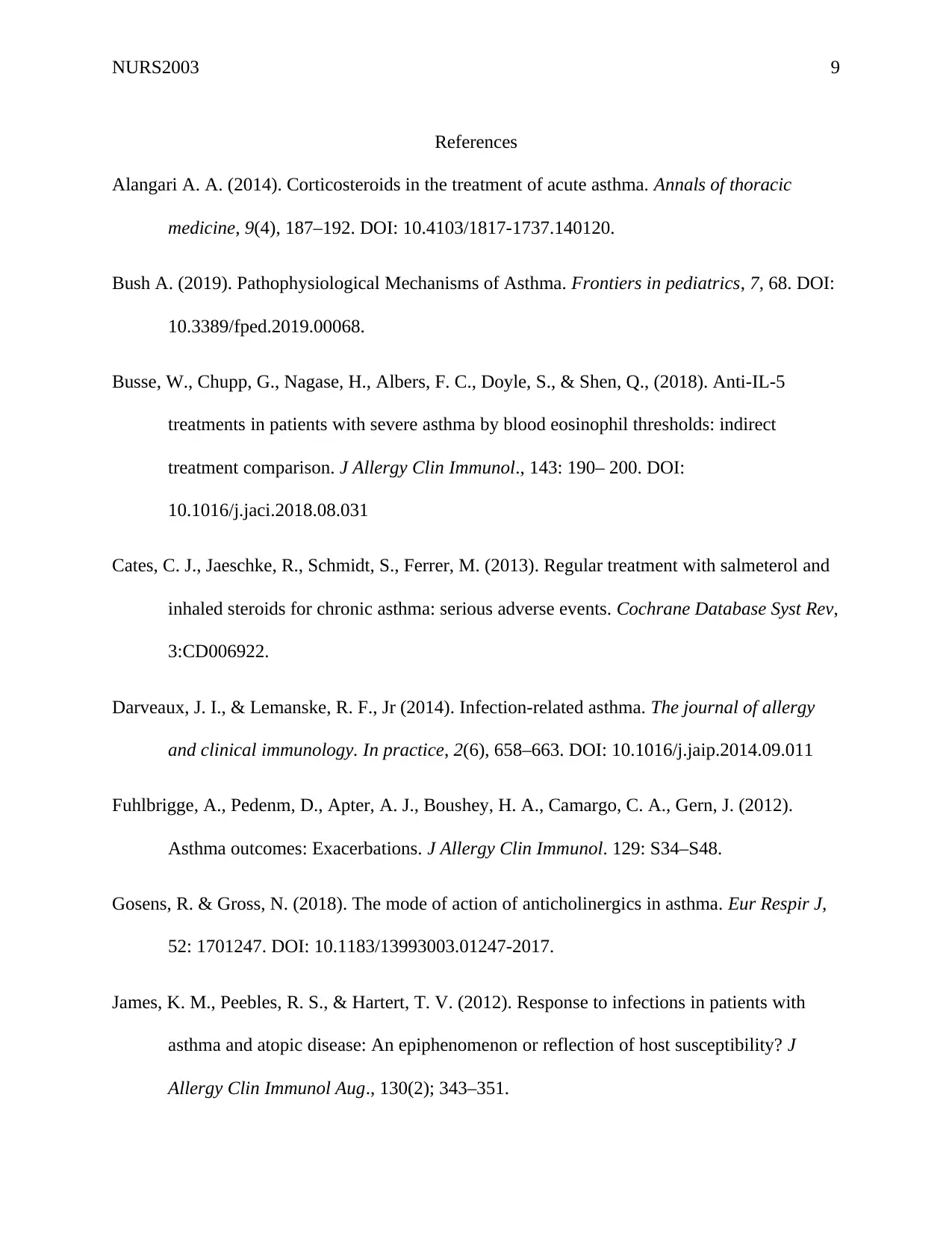
NURS2003 9
References
Alangari A. A. (2014). Corticosteroids in the treatment of acute asthma. Annals of thoracic
medicine, 9(4), 187–192. DOI: 10.4103/1817-1737.140120.
Bush A. (2019). Pathophysiological Mechanisms of Asthma. Frontiers in pediatrics, 7, 68. DOI:
10.3389/fped.2019.00068.
Busse, W., Chupp, G., Nagase, H., Albers, F. C., Doyle, S., & Shen, Q., (2018). Anti-IL-5
treatments in patients with severe asthma by blood eosinophil thresholds: indirect
treatment comparison. J Allergy Clin Immunol., 143: 190– 200. DOI:
10.1016/j.jaci.2018.08.031
Cates, C. J., Jaeschke, R., Schmidt, S., Ferrer, M. (2013). Regular treatment with salmeterol and
inhaled steroids for chronic asthma: serious adverse events. Cochrane Database Syst Rev,
3:CD006922.
Darveaux, J. I., & Lemanske, R. F., Jr (2014). Infection-related asthma. The journal of allergy
and clinical immunology. In practice, 2(6), 658–663. DOI: 10.1016/j.jaip.2014.09.011
Fuhlbrigge, A., Pedenm, D., Apter, A. J., Boushey, H. A., Camargo, C. A., Gern, J. (2012).
Asthma outcomes: Exacerbations. J Allergy Clin Immunol. 129: S34–S48.
Gosens, R. & Gross, N. (2018). The mode of action of anticholinergics in asthma. Eur Respir J,
52: 1701247. DOI: 10.1183/13993003.01247-2017.
James, K. M., Peebles, R. S., & Hartert, T. V. (2012). Response to infections in patients with
asthma and atopic disease: An epiphenomenon or reflection of host susceptibility? J
Allergy Clin Immunol Aug., 130(2); 343–351.
References
Alangari A. A. (2014). Corticosteroids in the treatment of acute asthma. Annals of thoracic
medicine, 9(4), 187–192. DOI: 10.4103/1817-1737.140120.
Bush A. (2019). Pathophysiological Mechanisms of Asthma. Frontiers in pediatrics, 7, 68. DOI:
10.3389/fped.2019.00068.
Busse, W., Chupp, G., Nagase, H., Albers, F. C., Doyle, S., & Shen, Q., (2018). Anti-IL-5
treatments in patients with severe asthma by blood eosinophil thresholds: indirect
treatment comparison. J Allergy Clin Immunol., 143: 190– 200. DOI:
10.1016/j.jaci.2018.08.031
Cates, C. J., Jaeschke, R., Schmidt, S., Ferrer, M. (2013). Regular treatment with salmeterol and
inhaled steroids for chronic asthma: serious adverse events. Cochrane Database Syst Rev,
3:CD006922.
Darveaux, J. I., & Lemanske, R. F., Jr (2014). Infection-related asthma. The journal of allergy
and clinical immunology. In practice, 2(6), 658–663. DOI: 10.1016/j.jaip.2014.09.011
Fuhlbrigge, A., Pedenm, D., Apter, A. J., Boushey, H. A., Camargo, C. A., Gern, J. (2012).
Asthma outcomes: Exacerbations. J Allergy Clin Immunol. 129: S34–S48.
Gosens, R. & Gross, N. (2018). The mode of action of anticholinergics in asthma. Eur Respir J,
52: 1701247. DOI: 10.1183/13993003.01247-2017.
James, K. M., Peebles, R. S., & Hartert, T. V. (2012). Response to infections in patients with
asthma and atopic disease: An epiphenomenon or reflection of host susceptibility? J
Allergy Clin Immunol Aug., 130(2); 343–351.
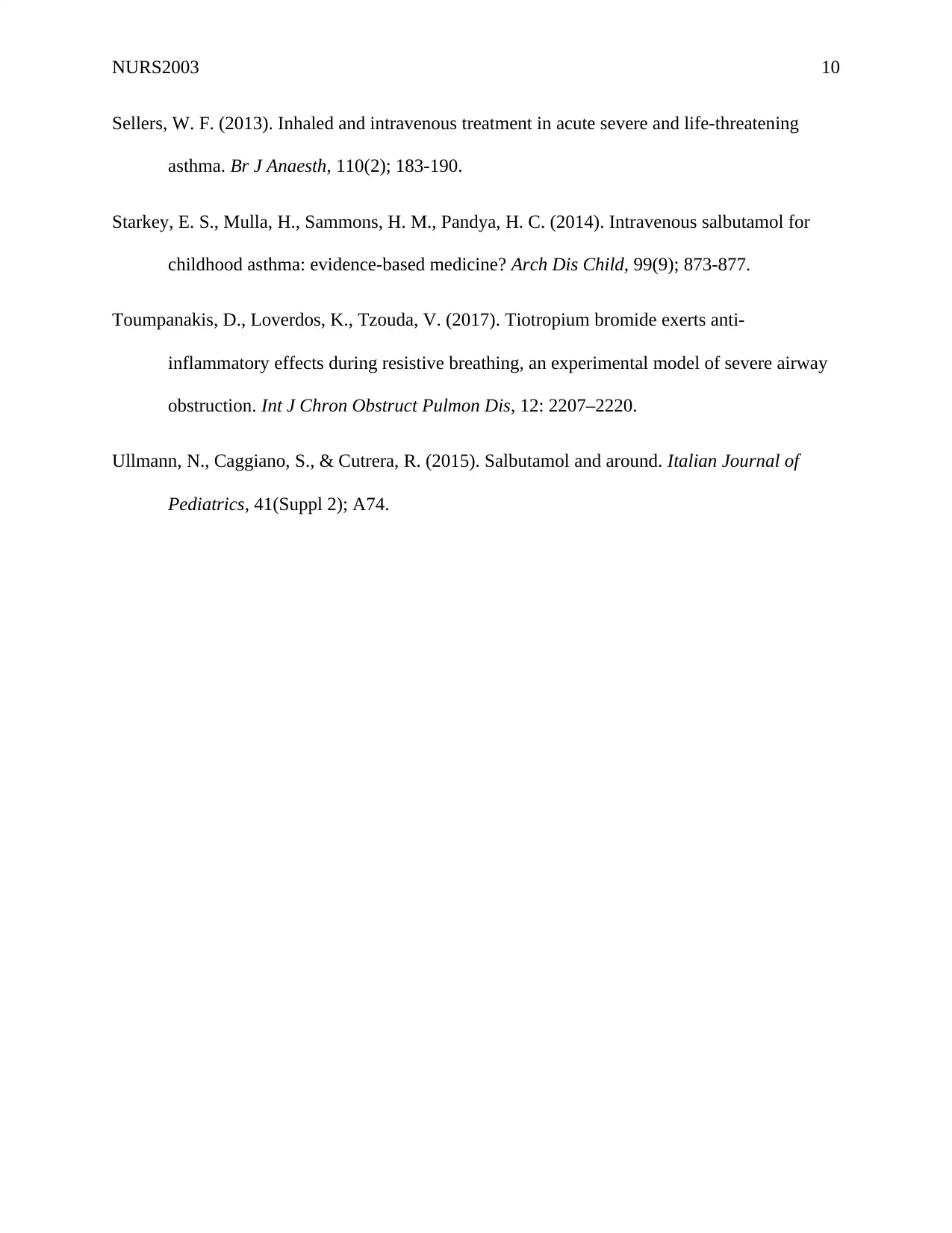
NURS2003 10
Sellers, W. F. (2013). Inhaled and intravenous treatment in acute severe and life-threatening
asthma. Br J Anaesth, 110(2); 183-190.
Starkey, E. S., Mulla, H., Sammons, H. M., Pandya, H. C. (2014). Intravenous salbutamol for
childhood asthma: evidence-based medicine? Arch Dis Child, 99(9); 873-877.
Toumpanakis, D., Loverdos, K., Tzouda, V. (2017). Tiotropium bromide exerts anti-
inflammatory effects during resistive breathing, an experimental model of severe airway
obstruction. Int J Chron Obstruct Pulmon Dis, 12: 2207–2220.
Ullmann, N., Caggiano, S., & Cutrera, R. (2015). Salbutamol and around. Italian Journal of
Pediatrics, 41(Suppl 2); A74.
Sellers, W. F. (2013). Inhaled and intravenous treatment in acute severe and life-threatening
asthma. Br J Anaesth, 110(2); 183-190.
Starkey, E. S., Mulla, H., Sammons, H. M., Pandya, H. C. (2014). Intravenous salbutamol for
childhood asthma: evidence-based medicine? Arch Dis Child, 99(9); 873-877.
Toumpanakis, D., Loverdos, K., Tzouda, V. (2017). Tiotropium bromide exerts anti-
inflammatory effects during resistive breathing, an experimental model of severe airway
obstruction. Int J Chron Obstruct Pulmon Dis, 12: 2207–2220.
Ullmann, N., Caggiano, S., & Cutrera, R. (2015). Salbutamol and around. Italian Journal of
Pediatrics, 41(Suppl 2); A74.
1 out of 10
Related Documents
Your All-in-One AI-Powered Toolkit for Academic Success.
+13062052269
info@desklib.com
Available 24*7 on WhatsApp / Email
![[object Object]](/_next/static/media/star-bottom.7253800d.svg)
Unlock your academic potential
© 2024 | Zucol Services PVT LTD | All rights reserved.





